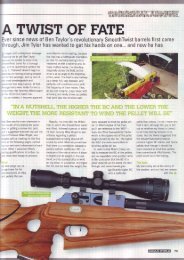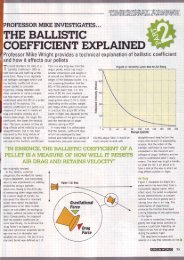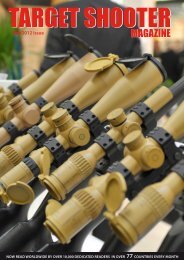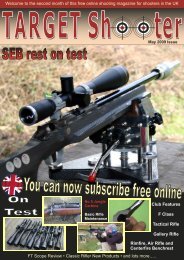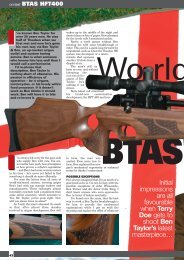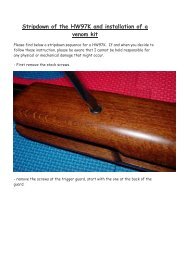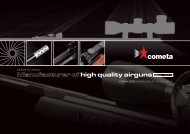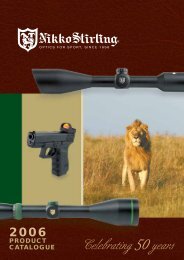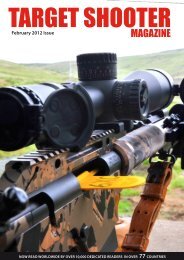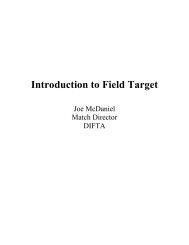Target Shooter 1
Target Shooter 1
Target Shooter 1
You also want an ePaper? Increase the reach of your titles
YUMPU automatically turns print PDFs into web optimized ePapers that Google loves.
NATO involvement in Iraq and Afghanistan has seen a resurgence<br />
in 7.62mm use including the low level sniper role by<br />
American forces, originally carried out with resurrected M21<br />
sniper rifles or scoped M14s as seen here, more recently the<br />
M110 ‘SASS’ rifle. (Courtesy of US Army image archives.)<br />
to Swiss company RUAG Ammotec for this year’s<br />
supply finally providing competitors in the UK’s<br />
most prestigious TR event with ammunition of a<br />
quality long taken for granted in Europe and the<br />
USA. These cartridges are loaded with the original<br />
155gn Sierra Palma MK (#2155) a mere quartercentury<br />
after its introduction. The downside is of<br />
course much increased cost, as you get what you<br />
pay for.<br />
Recent Developments<br />
The difference between .308 and 7.62mm bullet<br />
diameters has reduced, so recently built TR, and<br />
commercially produced tactical and sniper rifles<br />
have barrel specs that are only a little on the ‘tight’<br />
side or use standard .308 dimensions. Measuring<br />
a sample 155gn bullet pulled from a ‘Bisley Match’<br />
round produced a diameter precisely on 0.308”<br />
compared to 0.3077” for older 145gn bullets, and<br />
0.3082-0.3083” for Lapua and Sierra match<br />
examples. Note too that while still heavily ‘gunged’<br />
with sealant, it lacks a crimp-groove, and has a<br />
much longer bearing surface than the older type.<br />
Modern tactical rifles such as the Sako TRG<br />
and Accuracy International police and civilian<br />
models shoot very well with good .308W ammunition<br />
despite having ‘military’ chambers – one former<br />
Accuracy AE owner who did very well it did tell<br />
me however that it was important to fireform<br />
cases for the long chamber then ensure the resizing<br />
operation retained close headspace. American<br />
CLR (conventional prone long-range) shooters<br />
looked at our TR, liked what they saw and adopted<br />
it as ‘Fullbore Rifle’. In the USA, Fullbore and Palma<br />
are invariably shot using handloads and are run<br />
under two sets of ammunition rules at the<br />
organiser’s discretion – ‘International’ which<br />
sees bullet weight restricted to ‘less than 156gn’,<br />
72 <strong>Target</strong> <strong>Shooter</strong><br />
or unrestricted. F/TR is<br />
restricted to .223R and .308W<br />
but places no restrictions on<br />
bullet weights in the UK or USA<br />
(unlike British Commonwealth<br />
countries where the ‘less than<br />
156gn’ rule applies), so there is<br />
an ongoing debate about the ideal<br />
bullet for 1,000yd F/TR matches<br />
– an important subject as having<br />
the optimal combination makes<br />
a difference to the cartridge’s<br />
performance at this range,<br />
especially on the small F-Class<br />
target in difficult conditions.<br />
(Keeping shots in the four-ring or<br />
higher needs 18” or less dispersion<br />
at this range, in practice 13” for a<br />
rifle that groups into a half-MOA.)<br />
Resurgent<br />
One cannot look at the cartridge without<br />
noting its rebirth as a military tool. With NATO’s<br />
blanket adoption of the improved 5.56mm during<br />
the 1980s, there were strong pressures from military<br />
bureaucrats to withdraw 7.62mm weapons, sniper<br />
rifles aside, in the cause of standardisation and<br />
‘logistics’. However, the guys who actually put their<br />
lives on the line had a less than flattering view of<br />
the 5.56’s longer-range capabilities, especially the<br />
British ‘squaddie’ saddled with the unreliable L86A1<br />
‘LSW’ light machinegun version of the SA80 rifle.<br />
While 5.56 performed well – in obtaining hits and<br />
its terminal effectiveness – in short-range jungle<br />
wars, serious questions about its performance<br />
arose in the Balkans, even more so Iraq and<br />
Afghanistan where fighting ranges are much<br />
increased.<br />
The result has been retention, in fact much<br />
increased use, of 7.62mm ‘general-purpose’<br />
MGs such as the US M60 and UK L7A1 ‘Gimpy’<br />
alongside the newer 5.56mm FN ‘Minimi’ gun.<br />
Moreover, the Americans became concerned about<br />
the inability of the average GI or Marine to neutralise<br />
opponents with the 5.56mm M16 at any range<br />
above 300 metres resulting in the adoption of a new<br />
rifle – the Knights Armaments SR25 based M110<br />
7.62mm semi-auto sniper rifle firing M118LR 175g<br />
bullet cartridges – issued to considerable<br />
numbers of selected and specially trained rifle-squad<br />
‘marksmen’ who can hit targets at 500-600m<br />
as a supplement to the small numbers of highly<br />
specialised two-man scout / sniper teams. So the<br />
7.62’s role and likely future have seen a huge<br />
turnaround in western armies, the outlook moving<br />
from poor to assured.<br />
Next month – brass and bullets.



